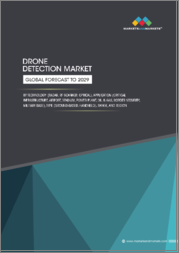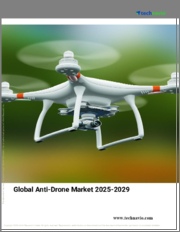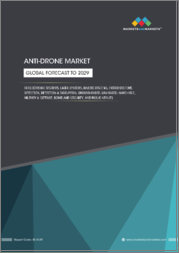
|
시장보고서
상품코드
1429279
세계의 안티 드론 시장 : 현황 분석 및 예측(2023-2030년)Anti-Drone Market: Current Analysis and Forecast (2023-2030) |
||||||
안티 드론 시장은 시장에서 소비자 드론이 쉽게 구할 수 있고 용도가 확대됨에 따라 약 11.71%의 강력한 CAGR로 성장할 것으로 예상됩니다. 또한, 소비자 드론은 다양한 산업에 혁명을 일으키며 전 세계의 상상력을 자극하는 등 큰 인기를 얻고 있습니다. 그러나 이러한 무인항공기(UAV)의 확산에 따라 잠재적인 위협을 줄이기 위한 대책이 시급한 실정입니다. 그 결과, 안티 드론 시스템 시장은 전 세계적으로 급성장하고 있습니다. 많은 드론 애호가들이 책임감 있게 드론을 조종하고 있지만, 소비자 드론의 무분별한 사용은 사생활 침해, 보안 침해, 중요한 업무 방해에 대한 우려를 불러일으키고 있습니다. 공항 근처에서 드론 목격, 무단 촬영, 밀수 시도 등의 사건은 시급히 해결해야 할 취약점을 부각시키고 있습니다. 이러한 위협으로부터 중요한 인프라, 공공 행사 및 민감한 지역을 보호하기 위해서는 강력한 안티 드론 시스템을 도입해야 합니다. 예를 들어, 2018년 런던 개트윅 공항에서 드론 활동으로 인해 약 1,000편의 항공편이 중단되어 14만 명 이상의 승객이 영향을 받은 사건이 있었습니다. 이 33시간의 혼란으로 인한 경제적 손실은 약 5,580만 유로로 추산됩니다.
기술별로 시장은 전자 시스템, 운동 시스템, 기타로 구분됩니다. 이 중 전자 시스템이 가장 큰 비중을 차지하고 있습니다. 전자 시스템은 레이더, 무선 주파수, 적외선 등 다양한 기술을 활용하여 레이더 시그니처를 기반으로 드론을 탐지합니다. 또한 이러한 시스템은 RF 및 GNSS 재밍과 같은 기술을 사용하여 드론과 운영자 간의 무선 주파수 연결을 방해하거나 드론의 위성 링크를 방해하여 미확인 항공기가 해당 지역에서 활동하지 못하도록 금지합니다. 전자 시스템의 인기는 설치 및 사용의 용이성 때문에 대중화에 크게 기여하고 있습니다.
용도에 따라 안티 드론 시장은 탐지 및 탐지-방해로 나뉩니다. 시장 점유율은 탐지 및 교란 안티 드론 시스템이 시장을 독점하고 있습니다. 그 주요 이유는 드론 위협에 대응하기 위한 종합적인 접근 방식 때문입니다. 드론의 존재를 식별하는 탐지 전용 시스템과는 달리, 탐지 및 방해 시스템은 위협을 적극적으로 완화할 수 있는 능력을 갖추고 있습니다. 이러한 시스템은 무허가 드론을 효과적으로 무력화할 수 있는 다층적 방어 메커니즘을 제공하며, 이러한 요소는 안티 드론 탐지 및 교란 시스템의 인기가 점점 더 높아지는 데 매우 중요한 역할을 합니다.
최종사용자별로 안티 드론 시장은 군사 및 국방, 상업, 정부 및 법집행기관으로 구분됩니다. 전 세계 시장에서 안티 드론 시스템에 대한 가장 큰 수요를 창출하는 것은 상업 부문입니다. 공항 근처에서 드론이 목격되면 비행 업무에 큰 지장을 초래하여 항공 산업에 수백만 달러의 피해를 입히고 있습니다. 마찬가지로 창고, 건설 현장, 제조 시설 근처에 무허가 드론이 존재할 경우 물류 업무에 지장을 초래하고 생산성을 떨어뜨릴 수 있습니다. 공항, 스포츠 경기장, 콘서트장, 쇼핑몰과 같은 상업 공간은 많은 관객을 대상으로 합니다. 악의적인 드론의 잠재적 위협은 공공의 안전을 위협하고, 업무를 방해하고, 광범위한 공황을 일으킬 수 있습니다.
시장은 북미(미국, 캐나다, 기타), 유럽(독일, 영국, 프랑스, 스페인, 이탈리아, 기타), 아시아태평양(중국, 일본, 인도, 기타) 및 기타 지역을 기준으로 분석되었습니다. 북미는 안티 드론 시장의 대부분을 차지하고 있으며, 예측 기간 동안 상당한 성장을 이룰 것으로 예상됩니다. 북미에서는 인프라, 국방, 치안, 대규모 이벤트 등 다양한 분야에서 보안에 대한 관심이 높아지고 있습니다. 이러한 보안에 대한 관심은 드론이 밀수, 테러, 사생활 침해 등 불법적인 행위에 악용될 수 있다는 위협에 대한 변화된 상황에 대한 직접적인 대응입니다. 이러한 위험에 대한 인식이 높아지면서 중요한 인프라를 보호하고 잠재적 위협을 완화할 수 있는 안티 드론 시스템에 대한 수요가 증가하고 있습니다. 또한, 북미의 국방 및 군사 부문은 드론 위협에 대응하는 것이 중요하다는 것을 인식하고 있습니다. 분쟁 시 비재래식 전쟁 전술에 드론을 활용하기 위해서는 강력한 안티 드론 기술 개발이 필요합니다. 국방 기관은 자국의 자산, 부대, 국경을 보호하기 위해 적대적인 무인항공기(UAV)를 탐지, 추적, 무력화할 수 있는 솔루션을 적극적으로 모색하고 있습니다. 예를 들어, 2022년 4월 미국의 아멘텀(Amentum)은 미국 국토안보부(DHS)와 2억 6,000만 달러 규모의 C-UAS 기술 및 시스템 시연 및 평가 계약을 체결한 바 있습니다. 이 계약에는 C-UAS 관련 사이버 취약성, 무선 주파수 스펙트럼 측정, 다양한 임무 분야에 걸친 프로토타입 C-UAS 시스템 통합 및 배치 분야의 연구개발 및 테스트 역량이 포함되며, 2023년부터 2028년까지 약 2억 4,000만 달러가 투입될 예정입니다.
목차
제1장 시장 서론
- 시장 정의
- 주요 목표
- 이해관계자
- 제한사항
제2장 조사 방법 또는 가정
- 조사 과정
- 조사 방법
- 응답자 프로파일
제3장 시장 요약
제4장 주요 요약
제5장 COVID-19가 안티 드론 시장에 미치는 영향
제6장 안티 드론 시장 매출(2020-2030년)
제7장 시장 인사이트 : 기술별
- 전자 시스템
- 운동 시스템
- 기타
제8장 시장 인사이트 : 용도별
- 감지
- 감지·방해
제9장 시장 인사이트 : 최종사용자별
- 군·방위
- 상업
- 정부·법집행기관
제10장 시장 인사이트 : 플랫폼별
- 지상
- 핸드헬드
- UAV 기반
제11장 시장 인사이트 : 지역별
- 북미
- 미국
- 캐나다
- 기타 북미
- 유럽
- 독일
- 영국
- 프랑스
- 이탈리아
- 러시아
- 기타 유럽
- 아시아태평양
- 중국
- 인도
- 일본
- 한국
- 기타 아시아태평양
- 세계 기타 지역
제12장 안티 드론 시장 역학
- 시장 성장 촉진요인
- 시장 과제
- 영향 분석
제13장 안티 드론 시장 기회
제14장 안티 드론 시장 동향
제15장 수요측과 공급측 분석
- 수요측 분석
- 공급측 분석
제16장 밸류체인 분석
제17장 경쟁 시나리오
- 경쟁 상황
- Porter's Five Forces 분석
제18장 기업 개요
- RTX
- Lockheed Martin Corporation
- Leonardo S.p.A.
- Thales
- IAI
- Rafael Advanced Defense Systems Ltd
- Blighter Surveillance Systems Limited
- DroneShield Ltd
- Dedrone
- DETECT, INC.,
제19장 면책사항
ksm 24.03.04Anti-drone systems, also known as counter-drone systems or drone defense systems, refer to various technologies and techniques designed to detect, identify, track, and neutralize unauthorized or potentially dangerous unmanned aerial vehicles (UAVs), commonly known as drones. These systems are developed with the primary objective of safeguarding various critical infrastructures, sensitive areas, events, and military installations from potential threats posed by rogue drones. The anti-drone systems utilize a combination of advanced sensors, surveillance techniques, and countermeasures to effectively counteract the unauthorized or malicious use of drones.
The Anti Drone Market is expected to grow at a strong CAGR of around 11.71% owing to the easy availability and expanding use of consumer drones in the market. Furthermore, consumer drones have gained immense popularity, revolutionizing various industries and capturing imaginations worldwide. However, with the proliferation of these unmanned aerial vehicles (UAVs) comes the pressing need for countermeasures to mitigate potential threats. As a result, the market for anti-drone systems is experiencing tremendous growth globally. While most drone enthusiasts operate responsibly, the unauthorized use of consumer drones has led to concerns over privacy, security breaches, and disruption of critical operations. Incidents of drone sightings near airports, unauthorized photography, and smuggling attempts highlight the vulnerabilities that need to be addressed urgently. Protecting critical infrastructure, public events, and sensitive areas from such threats necessitates deploying robust anti-drone systems. For instance, a notable event occurred in 2018 when London Gatwick Airport experienced the disruption of approximately 1,000 flights due to drone activity, impacting over 140,000 passengers. The resulting economic loss from the 33-hour disruption was estimated at around EUR 55.8 million.
Based on technology, the market is segmented into electronic systems, kinetic systems, and others. Among these categories, the electronic system dominates the market with the largest share. The electronic system utilizes various technologies such as radar, radio frequency, and infrared to detect drones based on their radar signature. Additionally, these system employs technologies like RF and GNSS jamming to disrupt the radio frequency connection between the drone and its operator, or to interfere with the drone's satellite link, thereby prohibiting unidentified aircraft from operating in the area. The electronic systems' popularity stems from their ease of installation and use, greatly contributing to their widespread growth.
Based on application, the anti-drone market is bifurcated into detection and detection and disruption. The detection and disruption anti-drone system dominated the market in terms of market share. The primary reason behind the domination is their comprehensive approach to countering drone threats. Unlike detection-only systems, which solely identify the presence of drones, detection, and disruption systems are equipped with the ability to actively mitigate the threat. These systems offer a multi-layered defense mechanism that ensures the effective neutralization of unauthorized drones, and factors like these have played a pivotal role in the ever-increasing popularity of detection and disruption of anti-drone systems.
Based on end-users, the anti-drone market is segmented into military and defense, commercial, and government and law enforcement agencies. The commercial segment generates the maximum demand for anti-drone systems in the global market. Drone sightings near airports have led to significant disruptions in flight operations, costing the aviation industry millions of dollars. Similarly, unauthorized drone presence near warehouses, construction sites, or manufacturing facilities can disrupt logistical operations and hamper productivity. Commercial spaces, such as airports, sports stadiums, concert venues, and shopping malls, cater to a vast audience. The potential threat of malicious drone activities jeopardizes public safety and can disrupt operations, causing widespread panic.
For a better understanding of the market adoption of white goods, the market is analyzed based on its worldwide presence in countries such as North America (The U.S., Canada, and the Rest of North America), Europe (Germany, The U.K., France, Spain, Italy, Rest of Europe), Asia-Pacific (China, Japan, India, Rest of Asia-Pacific), Rest of World. North America holds a significant portion of the anti-drone market and is projected to experience substantial growth in the predicted timeframe. Security is given great importance in various sectors within North America, including infrastructure, defense, public safety, and large-scale events. This heightened focus on security is a direct response to the changing threat landscape, where drones can be exploited for illegal activities, such as smuggling, terrorism, and invasion of privacy. The increasing recognition of these risks has driven the demand for anti-drone systems that can safeguard critical infrastructure and mitigate potential threats. Moreover, the defense and military sectors in North America have acknowledged the significance of countering drone threats. The utilization of drones in unconventional warfare tactics during conflicts has necessitated the development of robust anti-drone technologies. Defense agencies are actively searching for solutions that can detect, track, and neutralize hostile unmanned aerial vehicles (UAVs) to safeguard their assets, troops, and borders. For instance, In April 2022, American company Amentum was awarded a USD 260 million contract to demonstrate and evaluate C-UAS technologies and systems, for the Department of Homeland Security (DHS). This includes R&D and testing capabilities in the areas of C-UAS-related cyber vulnerabilities, radio frequency spectrum measurements, and integration and deployment of prototype C-UAS systems across various mission areas. Around USD 240 million is expected to be spent on this program over the period 2023-2028.
Some of the major players operating in the market include RTX; Lockheed Martin Corporation; Leonardo S.p.A.; Thales; IAI; Rafael Advanced Defense Systems Ltd; Blighter Surveillance Systems Limited; DroneShield Ltd; Dedrone; and DETECT, INC.,
TABLE OF CONTENTS
1 MARKET INTRODUCTION
- 1.1. Market Definitions
- 1.2. Main Objective
- 1.3. Stakeholders
- 1.4. Limitation
2 RESEARCH METHODOLOGY OR ASSUMPTION
- 2.1. Research Process of the Anti-Drone Market
- 2.2. Research Methodology of the Anti-Drone Market
- 2.3. Respondent Profile
3 MARKET SYNOPSIS
4 EXECUTIVE SUMMARY
5 IMPACT OF COVID-19 ON THE ANTI-DRONE MARKET
6 ANTI DRONE MARKET REVENUE (USD BN), 2020-2030F
7 MARKET INSIGHTS BY TECHNOLOGY
- 7.1. Electronic System
- 7.2. Kinetic System
- 7.3. Others
8 MARKET INSIGHTS BY APPLICATION
- 8.1. Detection
- 8.2. Detection and Disruption
9 MARKET INSIGHTS BY END-USER
- 9.1. Military and Defence
- 9.2. Commercial
- 9.3. Government and Law Enforcement Agencies
10 MARKET INSIGHTS BY PLATFORM
- 10.1. Ground
- 10.2. Handheld
- 10.3. UAV based.
11 MARKET INSIGHTS BY REGION
- 11.1. North America
- 11.1.1. The U.S.
- 11.1.2. Canada
- 11.1.3. Rest of North America
- 11.2. Europe
- 11.2.1. Germany
- 11.2.2. The U.K.
- 11.2.3. France
- 11.2.4. Italy
- 11.2.5. Russia
- 11.2.6. Rest of Europe
- 11.3. Asia-Pacific
- 11.3.1. China
- 11.3.2. India
- 11.3.3. Japan
- 11.3.4. South Korea
- 11.3.5. Rest of Asia-Pacific
- 11.4. Rest of the World
12 ANTI-DRONE MARKET DYNAMICS
- 12.1. Market Drivers
- 12.2. Market Challenges
- 12.3. Impact Analysis
13 ANTI-DRONE MARKET OPPORTUNITIES
14 ANTI-DRONE MARKET TRENDS
15 DEMAND AND SUPPLY-SIDE ANALYSIS
- 15.1. Demand Side Analysis
- 15.2. Supply Side Analysis
16 VALUE CHAIN ANALYSIS
17 COMPETITIVE SCENARIO
- 17.1. Competitive Landscape
- 17.1.1. Porters Fiver Forces Analysis
18 COMPANY PROFILED
- 18.1. RTX
- 18.2. Lockheed Martin Corporation
- 18.3. Leonardo S.p.A.
- 18.4. Thales
- 18.5. IAI
- 18.6. Rafael Advanced Defense Systems Ltd
- 18.7. Blighter Surveillance Systems Limited
- 18.8. DroneShield Ltd
- 18.9. Dedrone
- 18.10. DETECT, INC.,



















